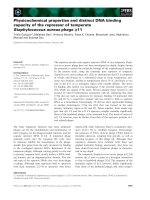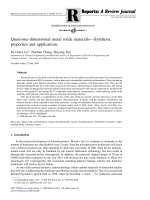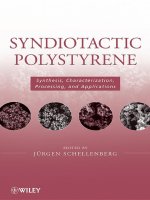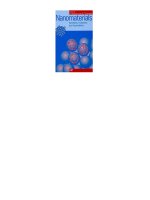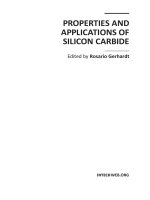Protein-based surfactants synthesis, physicochemical properties, and applications
Bạn đang xem bản rút gọn của tài liệu. Xem và tải ngay bản đầy đủ của tài liệu tại đây (3.94 MB, 301 trang )
ISBN: 0-8247-0004-X
This book is printed on acid-free paper.
Headquarters
Marcel Dekker, Inc.
270 Madison Avenue, New York, NY 10016
tel: 212-696-9000; fax: 212-685-4540
Eastern Hemisphere Distribution
Marcel Dekker AG
Hutgasse 4, Postfach 812, CH-4001 Basel, Switzerland
tel: 41-61-261-8482; fax: 41-61-261-8896
World Wide Web
The publisher offers discounts on this book when ordered in bulk quantities. For more
information, write to Special Sales/Professional Marketing at the headquarters address
above.
Copyright 2001 by Marcel Dekker, Inc. All Rights Reserved.
Neither this book nor any part may be reproduced or transmitted in any form or by
any means, electronic or mechanical, including photocopying, microfilming, and re-
cording, or by any information storage and retrieval system, without permission in
writing from the publisher.
Current printing (last digit):
10987654321
PRINTED IN THE UNITED STATES OF AMERICA
Preface
Surfactants have broad applications in many areas. For example, they are used
either as essential additives or as processing aids in production and processing
of materials that surround us. Surfactants are major constituents of laundry
detergents, industrial cleaners, and cosmetics. Some surfactants are used as
wetting, emulsifying, defoaming, or solubilizing agents in the pharmaceutical,
textile, food, and petroleum industries.
In recent years, environmental concerns and regulatory pressure have pro-
vided the driving force to replace petrochemical-based surfactants partly with
those based on naturally occurring renewable sources. There is a growing
interest in the synthesis and formulation applications of surfactants from natu-
ral biopolymers. The notion that such surfactants would be biodegradable and/
or biocompatible has provided strong incentive for research pursuit in this
area. For the aforementioned reasons, surfactants such as protein-based surfac-
tants (PBS) have attracted research attention. However, scientific information
for this group of surfactants is scanty. This book intends to narrow the knowl-
edge gap by presenting recent developments in this area.
Protein-based surfactants are usually synthesized with amino acids/peptides
and fatty acids as building blocks. They are mainly of two types: peptide and
amino acid surfactants. Both are interesting compounds that contain an amino
or a peptide as the hydrophilic part and a long hydrocarbon chain as the hy-
drophobic portion. The hydrocarbon chain can be introduced through acyl,
ester, amide, alkyl, or ether linkage. Protein-based surfactants are usually con-
iii
iv Preface
sidered biodegradable, nontoxic, and nonirritating and, in some cases, they
have antimicrobial properties. Information on the preparation, structure, and
properties of PBS is found mostly in the patent literature. Relatively few com-
mercial PBS are available.
The lack of a book devoted to PBS emphasizes the timeliness of and pro-
vides impetus for this book. The potential benefits of PBS are enormous and
will be highlighted in this volume to stimulate more research in the area. The
book provides insights into how underutilized protein and oil sources can be
converted to new surfactants of potentially high value. It suggests potential
large-volume new applications for waste and/or underutilized proteins in the
surfactant and detergent industries. Furthermore, it presents viewpoints on
chemical and enzymatic approaches in the synthesis of PBS. In general, the
book examines synthesis approaches and the physical chemistry of PBS, appli-
cation potentials, and the overall state of knowledge in the subject area.
This volume is intended for chemists, formulation chemists, physical chem-
ists, biologists, food scientists, and research scientists involved in the synthe-
sis, technology, properties, and application of new surfactants. Also, it is ex-
pected to serve as a reference source for graduate students or researchers in
the fields of colloid and surface chemistry or chemical technology and engi-
neering.
The book brings together fundamental and applied aspects of PBS, drawing
perspectives from diversified researchers to provide comprehensive informa-
tion on the subject. It provides viewpoints on synthesis (chemical, enzymatic,
or chemoenzymatic processes), properties (safety, antimicrobial, biodegrad-
ability, etc.), and other special features of PBS. The first of the ten chapters
provides an overview of surfactant properties, technology, application, envi-
ronmental issues, and new concepts in the field. Chapter 2 takes a look at the
natural raw materials and agricultural by-products for PBS synthesis. Chapter
3 discusses protein interactions at interfaces, reviewing enzymatic reactions at
the interfaces and naturally occurring protein surfactants. Chapter 4 discusses
amino acid surfactants, their chemical synthesis and physicochemical proper-
ties. Chapters 5 and 6 discuss enzymatic approaches to synthesis of PBS.
Chapter 7 describes the preparation and properties of ionic and nonionic sur-
factants containing peptides or amino acids with perhydrogenated or perfluo-
rinated chains. Chapter 8 provides insights on potential interactions of PBS
with other compounds. Chapter 9 discusses potential applications of PBS in-
cluding formulation, detergency, emulsion, foaming, cosmetics, personal
cares, biotechnology, and other industrial applications. Chapter 10 examines
the current market development and trends. Extensive references are given at
the end of each chapter so that the reader can obtain further details elsewhere.
Preface v
It is hoped that this volume will stimulate the interest of more researchers
in the academic world and the surfactant industry to intensify work in the area
of PBS and to facilitate the rapid movement of developments from laboratory
to pilot level, to generate novel surfactants of unique properties.
Ifendu A. Nnanna
Jiding Xia
Contents
Preface iii
Contributors ix
1. An Overview of the Basis, Technology, and Surface Phenomena of
Protein-Based Surfactants 1
Jiding Xia and Ifendu A. Nnanna
2. Natural Raw Materials and Enzymatic Modification of Agricultural
By-Products for Protein-Based Surfactants 15
Xiao-Qing Han
3. Protein Interaction at Interfaces 45
Yasuki Matsumura
4. Amino Acid Surfactants: Chemistry, Synthesis, and Properties 75
Jiding Xia, Ifendu A. Nnanna, and Kazutami Sakamoto
5. Enzyme-Catalyzed Synthesis of Protein-Based Surfactants:
Amphoteric Surfactants 123
Yasuki Matsumura and Makoto Kito
6. Arginine Lipopeptide Surfactants with Antimicrobial Activity 147
M. R. Infante, A. Pinazo, J. Molinero, J. Seguer, and P. Vinardell
vii
viii Contents
7. Essentially Fluorinated Synthetic Surfactants Based on Amino Acids
or Oligopeptides 169
Claude Selve, Christine Ge
´
rardin, and Ludwig Rodehu
¨
ser
8. Interactions of Amino Acid–Based Surfactants with Other
Compounds 197
Yun-Peng Zhu
9. Potential Applications of Protein-Based Surfactants 227
Ifendu A. Nnanna, Guang Yu Cheng, and Jiding Xia
10. Current Market Developments and Trends in Amino Acid–
and Protein-Based Surfactants 261
Kazutami Sakamoto
Index 281
Contributors
Guang Yu Cheng Coty International Development Center, Morris Plains,
New Jersey
Christine Ge
´
rardin LCPOC UMR 7565, CNRS–UHP, Universite
´
Henri
Poincare
´
—Nancy I, Vandoeuvre-les-Nancy, France
Xiao-Qing Han Systems of the Future, Kraft Research and Development
Center, Glenview, Illinois
M. R. Infante Technology of Surfactants, Departamento Tecnologı
´
ade
Tensioactivos, Instituto de Investigaciones Quı
´
micas y Ambientales de Barce-
lona, CSIC, Barcelona, Spain
Makoto Kito Professor Emeritus, Kyoto University, Kyoto, Japan
Yasuki Matsumura Division of Food Structure and Functionality, Research
Institute for Food Science, Kyoto University, Kyoto, Japan
J. Molinero Research and Development, The Colomer Group, Barcelona,
Spain
Ifendu A. Nnanna Protein Ingredients Research and Development, Proliant,
Inc., Ames, Iowa
ix
x Contributors
A. Pinazo Technology of Surfactants, Departamento Tecnologı
´
a de Tensio-
activos, Instituto de Investigaciones Quı
´
micas y Ambientales de Barcelona,
CSIC, Barcelona, Spain
Ludwig Rodehu
¨
ser LCPOC UMR 7565, CNRS–UHP, Universite
´
Henri
Poincare
´
—Nancy I, Vandoeuvre-les-Nancy, France
Kazutami Sakamoto Applied Research Department, AminoScience Labo-
ratories, Ajinomoto Company, Inc., Kanagawa, Japan
J. Seguer Laboratorios Miret, S.A. (LAMIRSA), Terrassa, Spain
Claude Selve LCPOC UMR 7565, CNRS–UHP, Universite
´
Henri Poin-
care
´
—Nancy I, Vandoeuvre-les-Nancy, France
P. Vinardell Departamento Fisiologı
´
a, Facultad de Farmacia UB, Barce-
lona, Spain
Jiding Xia Division of Surfactant Science and Technology, Department of
Chemical Engineering, Wuxi University of Light Industry, Wuxi, China
Yun-Peng Zhu Crompton Corporation, Dublin, Ohio
1
An Overview of the Basis,
Technology, and Surface Phenomena
of Protein-Based Surfactants
JIDING XIA Wuxi University of Light Industry, Wuxi, China
IFENDU A. NNANNA Proliant, Inc., Ames, Iowa
I. INTRODUCTION
Surfactants (short for surface-active agents) consist of a hydrophilic (water-
compatible) head group and a hydrophobic (water-repellent) hydrocarbon tail.
They affect all aspects of our daily life, either directly via household detergents
and personal care products or indirectly via the production and processing of
the materials that surround us. Generally, they are important industrial chemi-
cals widely used in the manufacture of household cleaning, personal care,
agricultural, and food products. Most commercial surfactants in the market
are synthesized by chemical process. Manufacturers of surfactants use a com-
bination of petrochemicals and natural feedstock. Cost, performance, and
availability considerations make the petrochemicals the raw materials of
choice among manufacturers. The petrochemicals used include paraffin, ben-
zene, olefin, fatty alcohol, fatty acid, fatty amine, ethanolamine, ethylene ox-
ide, propyl oxide, betaine, and imidazoline and their polymerized products.
However, some chemical intermediates from the preceding chemical groups
are used directly, for example, alkylbenzene from the condensation of paraffin
derivatives and benzene for manufacturing sulfonates through sulfonation with
SO
3
in a falling-film reactor. These are mainly anionic surfactants, such as
tetrapropylene benzene sulfonates.
Synthetic surfactants are usually produced in a series of strong and se-
vere conditions such as high pressure (hydrogenation for fatty alcohol
process), nitrogen protection (ethoxylation), and blended catalysts (alkyla-
1
2 Xia and Nnanna
tion, oxidation, ethoxylation, condensation, and polymerization). Due to
their complex raw materials and a series of chemical treatments, synthetic
surfactants prepared from petrochemicals often lead to by-products or isomers
of the main products (e.g., ortho- or meta- in linear alkyl sulfonates, disulfo-
nates in petrosulfonates or in methyl ester sulfonates), causing some quality,
environmental, or ecological problems [1]. They may be examined easily
by component and life cycle analysis [2,3]. Also, some minor harmful pro-
ducts are known to occur during chemical synthesis of many of the petro-
chemical-based surfactants. For example, the cancer-promoting substance
dioxane is formed during sulfonation of polyoxyethylenated alcohol to
make alcohol ether sulfate (AES), sultone that occurs during the abnormal
oxidative bleaching of olefin sulfonates (optional), or sulfamine in the reac-
tion of ethanolamine-like compounds with sulfoxidation. These potential
environmental and biological problems associated with petrochemical-
based surfactants are prompting the surfactant industries to seek natural alter-
natives.
The trend is toward mild and biodegradable surfactant products. The biode-
gradability issue is expected to be a major consideration in new product and
market development in the 21st century. Companies are looking into new sci-
ence and chemistry for developing mild, low-cost, biodegradable, and multi-
functional surfactants.
The commercial prospects of protein-based surfactants (PBS) is expected
to be huge, especially at the more expensive end of the market, such as phar-
maceutical formulations and personal care products, where a broad range of
functionality (e.g., safety, mildness to skin, high surface activity, antimicrobial
activity, biodegradability) is desired.
According to Myers [4], biodegradability may be defined as the removal
or destruction of chemical compounds through the biological action of living
organisms. Such degradation may be divided into two stages: (1) primary deg-
radation, leading to modification of the chemical structure of the material suf-
ficient to eliminate any surface-active properties, and (2) ultimate degradation,
in which the material is essentially completely removed from the environment
as carbon dioxide, water, inorganic salts, or other materials that are the normal
waste by-products of biological activity [4].
In this chapter we provide an overview of the basis, technology, and surface
phenomena of PBS. It is hoped that this overview will stimulate interest in
exploring strategies to develop PBS with desirable ecological and toxicologi-
cal properties. It is expected that increased environmental awareness among
consumers will drive the development of biological methods for the manufac-
ture of industrial-scale PBS.
Overview of Protein-Based Surfactants 3
II. PROTEINS AS A BASE FOR SURFACTANT
PREPARATION
Proteins are by nature amphipathic or amphiphilic molecules; that is, they
contain both a hydrophobic (nonpolar) and a hydrophilic (polar) moiety. How-
ever, natural proteins per se are not used as commercial surfactants. Rather,
proteins are modified by chemical or enzymatic means to products with sur-
face-active properties. The use of modified proteins based on casein, soybean,
albumen, collagen, or keratin is not new [5]. The Maywood Chemical Com-
pany introduced commercial protein-based surfactants (PBS) in the United
States in 1937. They were primarily condensation products of fatty acids with
hydrolyzed proteins [5]. Renewed interest in PBS has occurred not only as
products based on renewable raw materials (i.e., proteins and fatty acids), but
also as a solution to waste disposal for animal and vegetable protein by-
products [5]. Among the commercial PBS, the following trade names have
been active: Crotein, Lexein, Magpon Polypeptide, Protolate, Sol-U-Teins,
and Super Pro.
Proteins are highly specific polypeptide polymers with three-dimensional
structures that are formed by amino acids linked by peptide bonds in a set
arrangement. The 3-D structure results from crosslinkage or interaction de-
rived from amino acid sidechains and hydrogen bonds between peptides. Pro-
teins differ from synthetic polymers in two major ways. In proteins, the num-
ber and variety of monomer units are considerably greater than those used in
industrial polymer synthesis. Also, in a given protein species, the covalent
structure or monomer order is essentially the same, as is the total number of
monomer units. Thus, a given protein has a very narrow molecular weight
range. However, proteins are similar to synthetic surfactants, because they are
composed of both hydrophobic and hydrophilic amino acids that afford them
a certain degree of surface activity. The main molecular properties of proteins
responsible for their surface activity are size, charge, structural features, stabil-
ity, amphipathicity, and lipophilicity [6]. The balance of polar, nonpolar, and
charged amino acids determines the surface activity of proteins in a particular
system [6]. This amphipathic nature of protein molecule allows it to bind with
surfaces of different chemical nature [6].
Although various factors may affect the surface activity of proteins, a domi-
nant parameter is hydrophobicity [7]. It influences adsorption and orientation
of proteins at interfaces and correlates with surface activity in some instance
(see the references in Ref. 6). However, the contribution of amino acids to the
overall hydrophobicity of the protein is limited compared to the contribution of
a hydrophobic tail in classic surfactants, such as ethoxylated fatty acids [7].
4 Xia and Nnanna
Hydrophobic modification of protein can be achieved either by chemical or
enzymatic process to enhance the surface activity. The starting material in
such processes may be a polypeptide, a peptide, or an amino acid as the hydro-
philic part and a long hydrocarbon chain as the hydrophobic portion. The
hydrocarbon can be introduced through acyl, ester, or alkyl linkage [8]. The
following is a brief description of acylation and enzymatic modification strate-
gies.
A. Acylation Modification
Acylation is not just a widespread process among natural proteins but also
the most important chemical means to modify protein functionality. Acylating
agents include acyl anhydrides, acyl chlorides, and N-hydroxysuccinimide es-
ter. All the acylating reagents can react with nucleophilic groups such as
amino, phenolic (tyrosine), aliphatic hydroxyl (serine and threonine), and im-
idazole (histidine) groups, but the reactivity of these groups and the stability
of their acyl derivatives differ respectively. Serine and threonine hydroxyl
groups, which are weak nucleophiles, are not easily acylated in aqueous solu-
tions, but succinyl derivatives are rather stable, whereas acylates of histidine
and cysteine residues are unstable [9]. In most cases, the main groups involved
are the α- and ε-NH
2
, and to a lesser extent, the ESH and EOH groups.
Essentially, the hydrophobicity and surface activity of the protein molecule
can thus be tailored by controlling the molar ratio of the acyl anhydrides to
proteins.
Acylated protein hydrolysates are known to be very mild surfactants. In the
formulation of surfactants, the addition of small amounts of acylated protein
hydrolysates to the more strongly irritating bulk surfactants results in a more
than proportional improvement in their compatibility with the skin [10].
B. Enzymatic Modification
Enzymatic techniques can be used to endow proteins with surface-active func-
tionality. An enzymatic technique that has shown promise in enhancing sur-
face properties of proteins is a modified version of the classical ‘‘plastein’’
reaction. The plastein reaction is known to be a protease-catalyzed reverse
process in which a peptide–peptide condensation reaction [11,12] proceeds
through the peptidyl-enzyme intermediate formation [13]. It is essentially a
two-step process: enzymatic hydrolysis of a protein and plastein formation
from the hydrolysate peptides. A novel one-step process was developed as a
modified type of the plastein reaction by Yamashita et al. [14,15], which
Overview of Protein-Based Surfactants 5
allowed papain-catalyzed incorporation of l-methionine and other amino
acids directly into soy protein and flour. Although the novel one-step process
of amino acid attachment was first designed for nutritional improvement,
these researchers soon demonstrated its great potential for improving protein
amphiphilicity and functionality as well [16]. It was hypothesized that by
reacting a hydrophilic protein as the substrate with highly hydrophobic
amino acid ester as the nucleophile, a product with amphiphilic properties
would result from the localized regions of hydrophobicity [16]. To obtain
adequately hydrophilic proteins as substrates, succinylation could be used to
modify the proteins prior to their use as substrates for the one-step process
[16]. To obtain adequately hydrophobic nucleophiles, amino acid esters with
specific functional properties were produced [16]. For example, the application
of the papain-catalyzed one-step process for l-norleucine n-dodecyl ester at-
tachment to succinylate α-s
1
-casein yielded a surface-active 20-kDa product
with increased emulsifying activity compared to α-s
1
-casein or succinylated
α-s
1
-casein [17]. Other enzymatic approaches used in modifying protein’s sur-
face properties or in novel surfactant synthesis are discussed in subsequent
chapters.
III. CLASSIFICATION OF PROTEIN-BASED
SURFACTANTS
Although this book is focused primarily on the synthesis and application of
PBS from renewable sources or waste products, some naturally occurring PBS
will also be discussed briefly. Some of these naturally occurring PBS have
found applications in the pharmaceutical and personal care industries. Also,
this book is primarily about amino acid– and peptide-based surfactants, two
types of PBS that are discussed in some detail in the following sections.
A. Amino Acid Surfactants
Amino acid–based surfactants are derived from simple amino acids or mixed
amino acids from synthesis or protein hydrolysates. They are composed
of amino acid as the hydrophilic part and a long hydrocarbon chain as the
hydrophobic part. The hydrophobic chain can be introduced through acyl, es-
ter, amide, or alkyl linkage. Interest in amino acid surfactants is not new, as
shown by early work in the area. In 1909, Bondi performed the first research on
the introduction of a hydrophobic group to obtain N-acylglycine and N-acyla-
lamine [18]. Subsequent work in this area focused on N-acylamino acids, as
reported by Funk [19], Izar [20], Karrer [21], Staudinger and Becker [22],
6 Xia and Nnanna
Naudet [23], Tsubone [24], Heitmann [25], Kester [26], Fieser [27], Komatsu
[28], Takehara [29], Imanaka [30], Seguer [31], Hatsutori [32], Abramzon
[33], and others. Other derivatives of amino acids have also been prepared by
reacting epoxidized fatty acid with ammonium or amines [34].
Some properties and uses of amino acid surfactants have been reviewed
by Kariyoma [35]. A commercial amino acid surfactant, ‘‘Lamepon,’’ derived
from leather hydrolysates and a fatty acid acyl group has been reported. It was
used as a mild detergent, an emulsifier, or dyeing additives. The surfactants of
long-chain N
α
-acyl amino acid derivatives from pure amino acids or protein
hydrolysates have also been studied by many authors [36,37]. N-Acylsarcosi-
nates (Medialan) is used extensively in the chemical industry as an intermedi-
ate in the Rapidogen series of fast cotton dyestuff [38]. N-Acyl sarcosinate
salts are suitable for cosmetics, toothpaste, wound cleaners, personal cares,
shampoo, bubble-bath pastes, aerosols and synthetic bars [39], flooding and
reducing agents [40], and corrosion inhibitors [41]. Long-chain N-acylgluta-
mates are surfactants derived from glutamic acid with less irritation on the
skin than other conventional surfactants, such as SDS and LAS [42]. Acylglu-
tamates generally showed weak acidity in an aqueous solution, the pH of
which was almost equal to that of the human skin. Triethanolamine acylgluta-
mates (AGTn) has shown strong stability to calcium ions and could be used
with water having a hardness of 200–300 ppm calculated as CaCO
3
[42]. Hiro-
fumi Yokota reported that the solubility of N
ε
-acyllysine surfactant was
improved by the introduction of N
ε
-methyl group [43]. Ajinomoto Company
(Japan) developed a series of amino acid emollients, including glycinates, glu-
tamates, dl-pyrrolidone carboxylic acid salt of N
α
-cocoyl-l-arginine ethyl es-
ter, N
ε
-lauroyl-l-lysine, and polyaspartates (Amilite GCK-12, Amisoft, CAE,
Amihope, Aquadew SPA-30, and Eldew CL-301) [30]. A series of amphoteric
surfactants, glycinates, sodium salts of N-(2-hytroxyethyl)-N-(2-hydroxyal-
kyl)-β-alanines (Na-HAA) was prepared by adding methyl acrylate to N-(hy-
droxyalkyl)-ethanolamine and subsequent saponification [44]. Pure N-acyl
leucines of some structurally different and biologically active common fatty
acids were synthesized; the N-acyl leucines exhibited greater activity in acid
form than the methyl ester form and against gram positive bacteria than gram
negative bacteria [45]. Sodium salts of long-chain N-alkyl-β-alanines, includ-
ing N-(2-hydroxyalkyl-N-(2-hydroxyalkyl)-β-alanines, have been prepared
that showed a wide pH range activity and less toxicity and irritation to human
skin because of their structural similarity to amino acid [46–49]. Infante et
al. synthesized a series of long-chain N
α
-acyl-l-arginine, long-chain N
α
-acyl-
l-lysine, and a commercial cationic amino acid surfactant, N
ε
-N
ε
-N
ε
t-trimethyl
N
α
-lauroyl-l-lysine methyl (LLM
q
) iodide [50].
Overview of Protein-Based Surfactants 7
Amino acid esters and amides are known to display excellent emulsifying
characteristics and to possess strong antimicrobial properties [51–54], which
makes them attractive as food additives [54]. Recently, Xia et al. [53] prepared
and evaluated the structure–function relationships of acyl amino acid surfactants
and their surface activity and antimicrobial properties. The amino acid surfac-
tants had a general structure of α-amino-(N-acyl)-β-alkoxypropionate. A strong
correlation existed between the critical micelle concentration (cmc) of amino
acid surfactants and the chain length of the acyl group, as evident from Fig. 1,
and also with their minimum inhibitory concentration (MIC) against Esche-
richia coli, Pseudomonas aeruginosa, Aspergillus niger,andPseudomonas cer-
evisiae (see Table 1). Using methyl p-hydroxybenzoate as a control, the amino
acid surfactants were shown to have 2–8, 64, and 4–8 times the activity against
gram-negative, gram-positive bacteria, and fungi, respectively [53].
The foregoing is an example of many kinds of amino acid–based surfac-
tants that are being produced either for investigative research or for commer-
cialization. They have potential wide application in the cosmetic, personal
care, food, and drug industries.
FIG. 1 Relationship of acyl group chain length of amino acid surfactants to critical
micelle concentration (cmc). (From Ref. 53.)
8 Xia and Nnanna
TABLE 1 Correlation Between Log MIC for Microorganisms and Log
CMC of Amino Acid Surfactants
a
Correlation
Microorganism Regression
b
coefficient (R
2
)
Staphylococcus aureus Y ϭϪ1.4742 ϩ 0.3611X 0.080
Escherichia coli Y ϭϪ11.843 Ϫ 3.1745X 0.878
Pseudomonas aeruginosa Y ϭ 1.8777 ϩ 1.9712X 0.876
Aspergillus niger Y ϭ 0.6358 ϩ 1.0917X 0.788
Saccharomyces cerevisiae Y ϭ 1.4676 ϩ 1.4123X 0.940
MIC ϭ minimum inhibitory concentration; CMC ϭ critical micelle concentration.
a
Amino acid surfactants of the general structure α-amino-(N-acyl)-β-alkoypropionate.
b
Y ϭ log MIC; X ϭ log CMC.
Source: Ref. 53.
B. Peptide Surfactants
Peptide surfactants are derived from the condensation of dipeptides or tripep-
tides and hydrophobic chains such as fatty acids. Most in the literature have
been synthesized chemically, although some have been produced biosyntheti-
cally. A number of useful reports on peptide surfactants have appeared in the
literature. A few examples are cited here.
In a novel approach, Mhasker and Lakshminerayama [52] synthesized di-
ethanolamides (DEA) of N-lauroyl dipeptides of various molecular structures.
N-Lauroyl condensates of five amino acids were coupled with the correspond-
ing amino acid methyl esters, and the resulting products were condensed with
DEA in the presence of sodium methoxide to yield DEA of N-lauroyl dipep-
tides [52]. The physicochemical properties of the DEA-dipeptides showed that
C12-glutamic-glutamic-DEA derivatives had a CMC of 0.13 wt% and a sur-
face tension of 32.5 MN/m at 0.1 wt%; C12-glycine-glycine-DEA derivatives
possessed good surface properties; C12-proline-proline-DEA had good wet-
ting and emulsifying properties; C12-cysteine-cysteine-DEA was a good
foaming agent. Their work showed correlation of the N-lauroyl dipeptides
derivatives with surface activities and antimicrobial property [52]. For exam-
ple, the leucine derivative showed maximum inhibition against both gram-
positive and gram-negative bacteria. Also, whereas the DEA of glycine and
phenylalanine were active against both bacteria, the cyclic structure of proline
contributed to the activity only against gram-positive bacteria. The cysteine
derivative did not show any inhibition against both bacteria. The authors [52]
concluded that the thiol group in cysteine does not impart any antimicrobial
activity to the derivatives. They further stated that the activity of the isobutyl
Overview of Protein-Based Surfactants 9
sidechain in leucine in inhibiting the bacteria was more pronounced than the
benzyl group in phenylalanine and the hydrogen atom of glycine [52]. The
DEA derivatives of N-lauroyl dipeptides were nonionic, mild to the skin, and
biodegradable surfactants.
Recently, Infante et al. [51] synthesized acidic and basic N
α
-lauroyl argi-
nine dipeptides, as methyl esters and free carboxylic acids, from pure amino
acids. They found that amphoteric N
α
-lauroyl-l-arginine dipeptide surfactants
containing glutamic acid or lysine had no antimicrobial activities. However,
the cationic versions of these peptides were antimicrobial, particularly the di-
peptide derivatives containing lysine [51].
Also of interest are amphoteric perfluoroalkylated homologues of N-(2-
hydroxy alkyl) amino acids prepared by the addition of 2-perfluoroalkyl-1,2-
epoxy ethane to a starting (l,d or l ) amino acid (glycine, alanine, β-alanine,
serine, 2-amino butyric acid, norvaline, norleucine, methionne, sarcosine,
aspartic acid, or glutamic acid). The presence of perfluoroalkyl groups pro-
duces a much more rigid and stable system, which in turn can lead to higher
gel-to-liquid-crystal-phase transition temperatures [55,56]. Meanwhile, the
presence of polyfluoro-alkyl groups in peptide surfactants lowers the surface
tension markedly and could enhance the polarity of the compound [57]. Fluori-
nated peptide surfactants are described in more detail in a later chapter.
In addition to the preceding examples of protein-based surfactants, there are
numerous biosurfactants that are produced by microorganisms as metabolic
products. For example, surfactin is a lipopeptide-type biosurfactant produced
by various strains of Bacillus subtilis and is one of the most powerful biosur-
factant so far known [58]. Interest in biosurfactants is increasing, for two rea-
sons: their diversity and biodegradability. There are also peptide-based surfac-
tants that are of animal and plant origin. They are usually antimicrobial in
function and are typically cationic (i.e., contain excess lysine and arginine
residues) amphipathic molecules composed of 12–45 amino acid residues
[59]. These antimicrobial peptides are described as exhibiting an α-helical
structure or containing β-sheet elements with a α-helical domain, whereas
others are usually rich in proline, tryptophan, or histidine residue [59].
IV. SYNTHESIS OF PROTEIN-BASED SURFACTANTS
A. PBS Building Blocks—Hydrophobic and
Hydrophilic Groups
As indicated previously, as is the case with many surfactants, the molecules
of PBS have the hydrophobic groups, have hydrophilic portions, and connect
with intermediate linkage. The hydrophobic moieties may be a long hydrocar-
10 Xia and Nnanna
bon chain (generally C
8
–C
25
) in a linear, branched, or cyclic state. The hydro-
phobicity depends on the degree of chain branching, chain length, and chain
distribution. Mostly the unsaturated or branched hydrocarbon chains have
weak hydrophobicity. Hydrophilic moieties are the short polar or ionic por-
tion, which can interact strongly with the water via dipole–dipole or ion–
dipole interaction, such as the atoms O, N, P, S, and the groups ECOO
Ϫ
,
ESO
3
Ϫ
, ESO
3
H, EPO
3
2ϩ
, EN(CH
3
)
2
O
Ϫ
, EN(CH
3
),
ϩ
ES(NH
3
)
2
ϩ
,
EN(CH
3
)
2
CH
2
CH
2
O
Ϫ
, E(CH
2
CH
2
O)
n
H, EOH, ESH, ECOOH, ENHCOE,
ENH
2
, EPD, and so on.
The intermediate linkages are used as the connecting portion between hy-
drophobic and hydrophilic groups if they are not connected to each other di-
rectly. By inserting the weak functional groups in hydrophobic groups, the
performance of surfactants may be improved and modified as a multifunctional
surfactant so that the hydrophobicity and hydrophilicity within a molecule can
be adjusted in a designed manner. Some practical intermediate linkages are
as follows: ECH
2
E, ECH
2
ECH
2
OE, ESE, ECOOE, ECONHE,
ENHCONHE. For example,
RCOENECH
2
CH
2
COONa
CH
3
ECONE and ECH
2
ECH
2
E are used as intermediate linkage between R
and ECOONa groups to increase the calcium ion tolerance and moderate
mildness of RCOONa compound.
As has been indicated before in this chapter, it is possible to synthesize PBS
by enzymatic techniques. More will be discussed on this subject in subsequent
chapters. It is worth mentioning here selected work that has utilized the en-
zyme approach. Enzymatic acylation of the α-amino group of amino acid am-
ides, using free fatty acids or their methyl esters, has been reported [60,54].
A range of N
ε
-acyl amino acid amides was prepared with up to 50% yield
[54]. The products were quantitatively converted into N-acyl-amino acids by
means of a second enzyme, carboxypeptidase Y [54]. For more information
on similar enzymatic approach, see the review by Sarney and Vulfson [54].
More recently, Izumi et al. [61] demonstrated enzymatic synthesis of N-acyl-
amino acid homologous series in organic media. They performed enzymatic
amidation of 3-amino-propionitrile and β-alanine ethyl ester using methyl lau-
rate and immobilized lipase from Candida antarctica. This resulted in the
formation of N-lauroyl-β-alanine ethyl ester and 3-N-lauroyl amino propioni-
trile, respectively, with the best yield (82%) attained using dioxane as solvent
[61].
Overview of Protein-Based Surfactants 11
FIG. 2 Chemoenzymatic approach to the synthesis of 1-O-(l-aminoacyl)-3-O-myris-
toylglycerols. (From Ref. 62.)
Although both chemical and enzymatic synthetic methods have their
uniqueness and limitations, a combination of the two approaches in the synthe-
sis of PBS may be advantageous. The area of chemoenzymatic synthesis has
been studied only a little, so not enough information is available to discuss
its merits. Nevertheless, Rao et al. [62] described that glycerol-linked amino
acid fatty acid esters can be obtained by a chemoenzymatic synthesis, as shown
schematically in Fig. 2, with conversions of 50–90%.
V. SUMMARY AND CLOSING REMARKS
Several PBS have been studied, usually with amino acid/peptide and fatty
acids as building blocks. Some are used as emulsifying agents in the cosmetic
and pharmaceutical industries. They also play a role in biochemical research
as detergents for the isolation and purification of membrane proteins. Informa-
12 Xia and Nnanna
tion on the preparation, structure, and properties of PBS is found mostly in the
patent literature. Protein-based proteins are usually considered biodegradable,
nontoxic, nonirritating components of detergents and, in some cases, have
antimicrobial properties.
Of the PBS, amino acid surfactants have been the subject of many studies,
primarily on their applications as pharmaceuticals, biomedicals, cosmetics,
household cleaners, and antimicrobial agents. On the other hand, except for
few fragmentary reports, experimental work on peptide surfactants is rela-
tively scanty. Both amino acid surfactants and peptide surfactants are interest-
ing biocompatible compounds that contain amino acid or dipeptide as the hy-
drophilic part and a long hydrocarbon chain as the hydrophobic part. The
hydrocarbon chain can be introduced through acyl, ester, amide, or alkyl
linkage.
It is important to note renewable resources such as natural oils and proteins,
especially those that are underutilized or ordinarily would go to waste, could
afford the basis of new surfactant molecules. Surfactants derived from natural
oils and proteins should be biodegradable and potentially of low toxicity.
The subsequent chapters will discuss the following areas in greater detail:
structure–function of proteins, with specific reference to their surface
property/interfacial behavior, amino acid surfactants, both chemically and en-
zymatically synthesized; peptide surfactants; and potential applications and
the market assessment of PBS.
REFERENCES
1. P. A. Gilbert, Proceedings of 4th World Surfactants Congress, 1:57, Barcelona,
1996.
2. P. Avidsen, Proceedings of 4th World Surfactants Congress, 3:352, Barcelona,
1996.
3. J. L. Berna, Proceedings of 4th World Surfactants Congress, 3:321, Barcelona,
1996.
4. D. Myers, in Surfactant Science and Technology, VCH Publishers, New York,
1988, p 21.
5. R. D. Cowell and B. R. Bluestein, in Amphoteric Surfactants (B. R. Bluestein
and C. L. Hilton, eds.), Marcel Dekker, New York, 1982, pp 265–279.
6. S. Magdassi and A. Kamyshny, in Surface Activity of Proteins (S. Magdassi,
ed.), Marcel Dekker, New York, 1997, p 3.
7. S. Magdassi and O. Toledano, in Surface Activity of Proteins (S. Magdassi, ed.),
Marcel Dekker, New York, 1997, pp 39–60.
8. J. Molinero, M. R. Julia, P. Erra, M. Robert, and M. R. Infante, J. Am. Oil Chem.
Soc. 65:975 (1988).
Overview of Protein-Based Surfactants 13
9. A. P. Gounaris and G. E. Periman, J. Biol. Chem. 242:2739 (1967).
10. A. Sander, Fett-Lipid 99(4):115 (1997).
11. A. I. Virtanen, Makromol. Chem. 6:94 (1951).
12. M. Yamashita, S. Arai, S. Tanimoto, and M. Fujimaki, Agric. Biol. Chem. (Ja-
pan) 37:95 (1973).
13. S. Tanimoto, M. Yamashita, S. Arai, and M. Fujimaki, Agric. Biol. Chem. (Ja-
pan) 36:1595 (1972).
14. M. Yamashita, S. Arai, Y. Imaizumi, and M. Fujimaki, J. Agric. Food Chem.
27:52 (1979).
15. M. Yamashita, S. Arai, Y. Ahrano, and M. Fujimaki, Agric. Biol. Chem. (Japan)
43:1065 (1979).
16. S. Nakai and E. Li-Chan, in Hydrophobic Interactions in Food Systems, CRC
Press, Boca Raton, FL, 1988, pp 145–151.
17. S. Arai and M. Watanabe, Agric. Biol. Chem. (Japan) 44:1979 (1980).
18. S. Bondi, Z. Biochem. 17:543 (1909).
19. C. Funk, Z. Physiol. Chem. 65:61 (1910).
20. G. Izar, Biochem. 40:390 (1912).
21. P. Karrer, Chim. Acta 8:205 (1930).
22. H. Staudinger and H. V. Becker, Ber. Deut. Chem. 70:889 (1937).
23. M. Naudet, Bull. Soc. Chim. France 358 (1950).
24. T. Tsubone, J. Japan. Biochem. Soc. 35:67 (1963).
25. P. Heitmann, Eur. J. Biochem. Soc. 3:346 (1968).
26. E. B. Kester, U.S. Patent 2,463,779 (1949).
27. M. Fieser, J. Am. Chem. Soc. 78:2825 (1956).
28. S. Komatsu, Japan Patent 29,444 (1964).
29. M. Takehara, J. Am. Oil Chem. Soc. 49:157 (1972).
30. T. Imanaka, Jpn. Kokao Tokkyo Koho, JP05140057, 1993.
31. J. Seguer, New J. Chem. 18, 6:765–774 (1994).
32. M. Hatsutori, Jpn. Kokai Tokkyo Koho, JP0761952, 1995.
33. A. A. Abramzon, Zh. Prikl Khim, 68, 7:1178–1181 (1995) (Russian).
34. A. H. Cook and S. F. Coox, J. Chem. Soc. 2334 (1949).
35. Kariyoma, Yushi 45(4):75–82 (1992); 45(5):83–89 (1992).
36. R. K. Yoshida, J. Jpn. Oil Chem. Soc. 25:404 (1976).
37. H. Goldschmidt and J. Lubowe, Amer. Cosm. Perf. 87:35 (1972).
38. A. M. Schwartz and J. W. Perry, Surface Active Agents, Their Properties and
Technology, R. E. Krieyer, Huntington, NY, 1978, p 35.
39. Y. T. Yakoto Yuichi, JP. Patent 02,237,911; CA, 114:128, 807h (1991).
40. D. Bradly, U.S. Patent 3,402,990 (1968).
41. M. Ako and K. Hideo, JP. Patent 01,164,446 (1989).
42. M. Takehara, I. Yoshimura, and R. Yoshida, J. Am. Oil Chem. Soc. 51:419–
423 (1974).
43. H. Yokota, J. Am. Oil Chem. Soc. 62:1716–1719 (1985).
44. Ajinomoto Inc. Report, Kanayama, Japan (1997).
45. S. Y. Mhaskar, J. Am. Oil Chem. Soc. 70:19 (1993).
14 Xia and Nnanna
46. C. Blustein, J. Am. Oil Chem. Soc. 50:532 (1973).
47. T. Okumura, Bull. Chem. Soc. Jpn. 47:1067 (1974).
48. C. D. Moor, Soc. Chem. Ind. (London) Monograph 19:193 (1965).
49. Takal, J. Am. Oil Chem. Soc. 54:537–541 (1979).
50. M. R. Infante, J. Molinero, P. Erra, M. R. Julid, and J. J. Garcia Demingues,
Fette Seifen Anstrichmittel 87(8):309 (1985).
51. M. R. Infante, J. Mollnero, P. Bosch, M. R. Julia, and P. Erra, J. Am. Oil Chem.
Soc. 66(12): 1835 (1989).
52. S. Y. Mhasker and G. Lakshminerayana, J. Am. Oil Chem. Soc. 69:643 (1992).
53. J. Xia, Y. Xia, and Nnanna. J. Agric. Food Chem. 43:867 (1995).
54. D. B. Sarney and E. N. Vulfson. Trends in Biotech. 13:164 (1995).
55. M. Nasreddine, S. Szonyi, and A. Cambon. J. Am. Oil Chem. Soc. 70:1 (1993).
56. M. Nasreddine, S. Szonyi, and A. Cambon. Synth. Commun. 22:1597 (1992).
57. Daikin Kogyo Co., European Patent 0043108 (1981).
58. Y-H. Wei and I-M Chu, Enzyme Microbial Technol. 22:724 (1998).
59. R. E. W. Hancock and R. Lehrer, Trends in Biotech. 16:82 (1998).
60. S. E. Godtfredsen and F. Bjorkling. World Patent No. 90/14429 (1990).
61. T. Izumi, Y. Yagimuma, and M. Haga. J. Am. Oil Chem. Soc. 74:875 (1997).
62. V. Rao, P. Jauregi, I. Gill, and E. Vulfson. J. Am. Oil Chem. Soc. 74:879 (1997).

